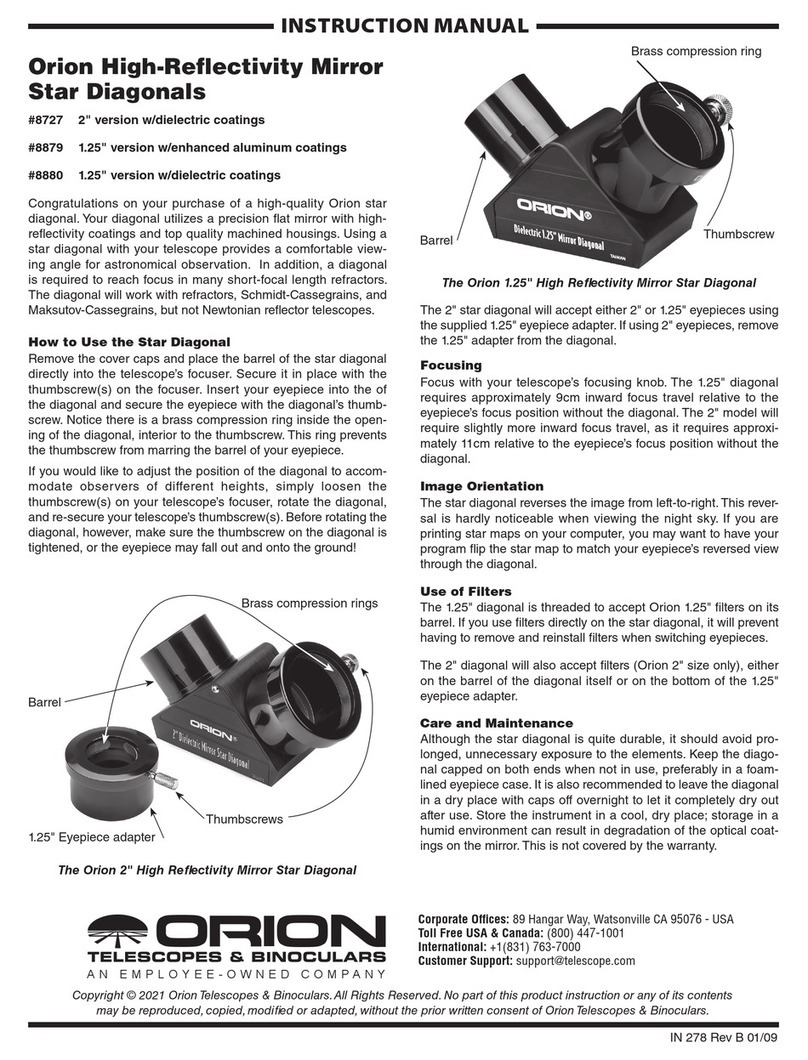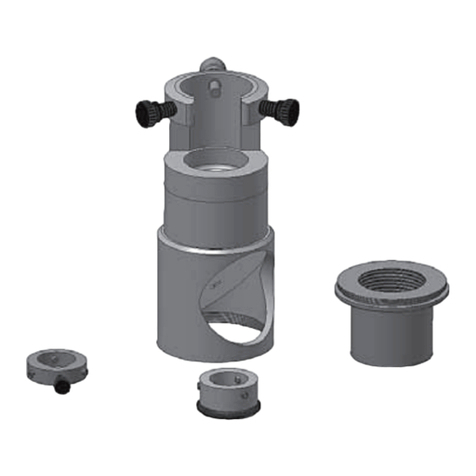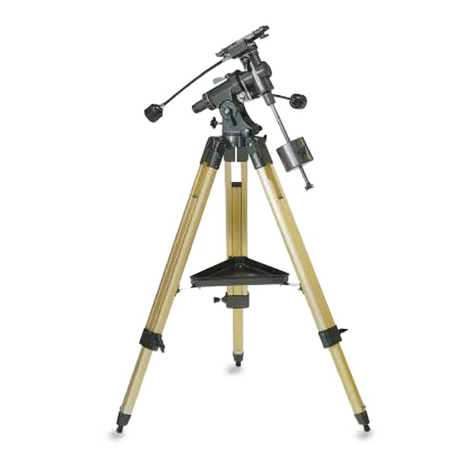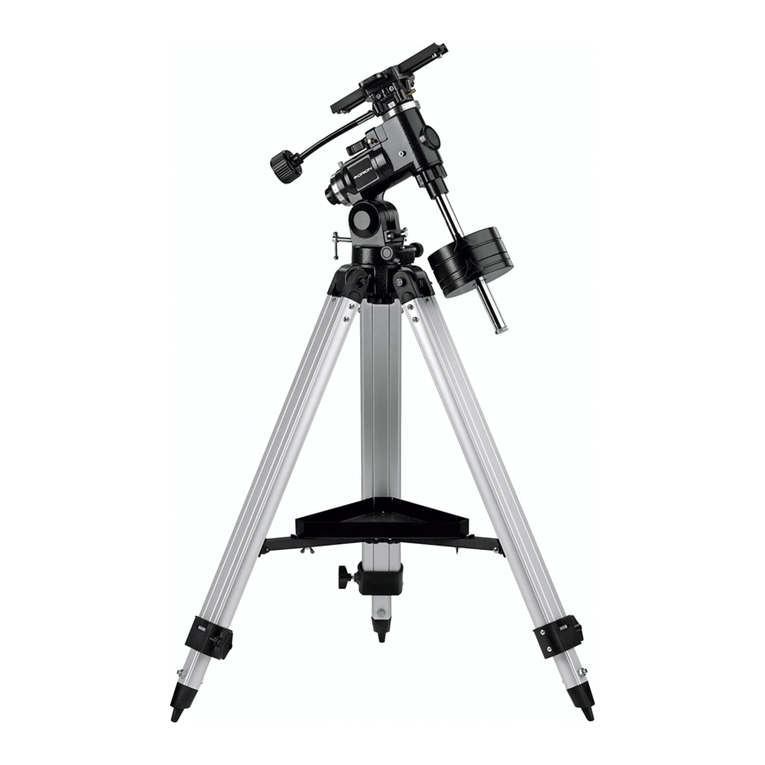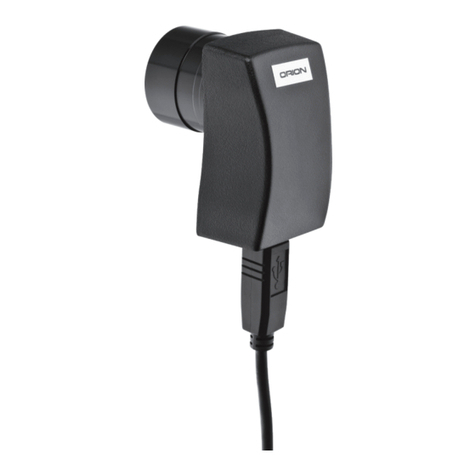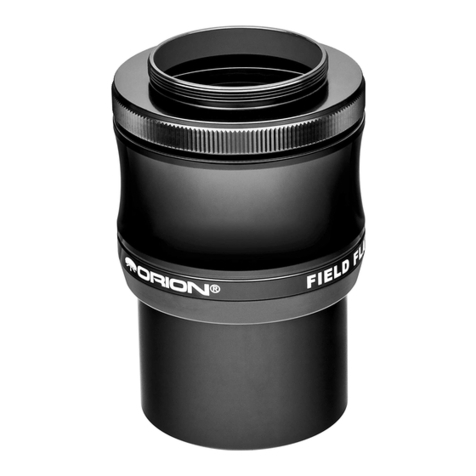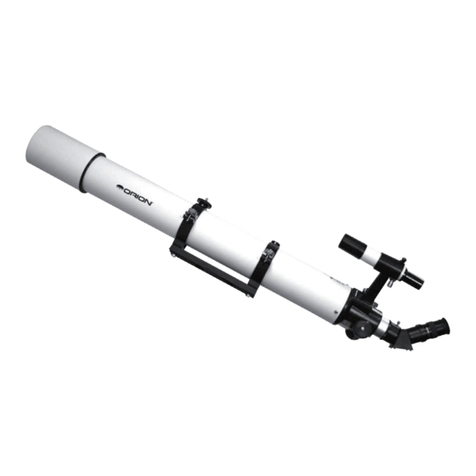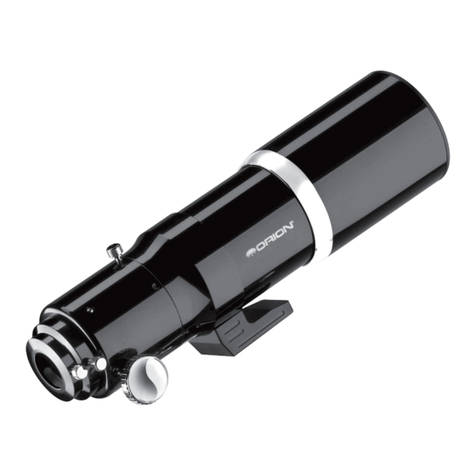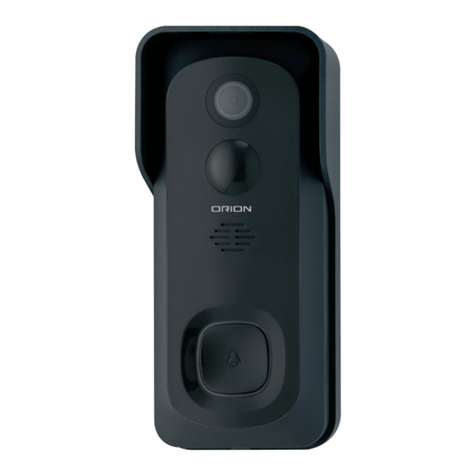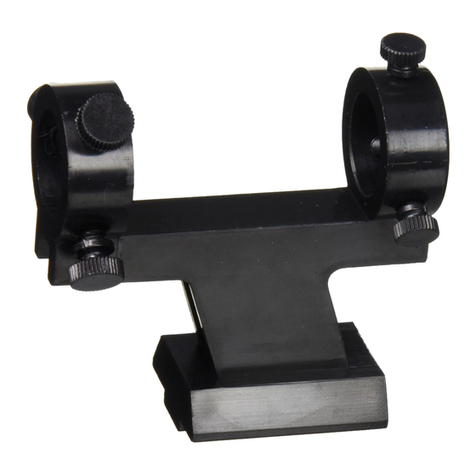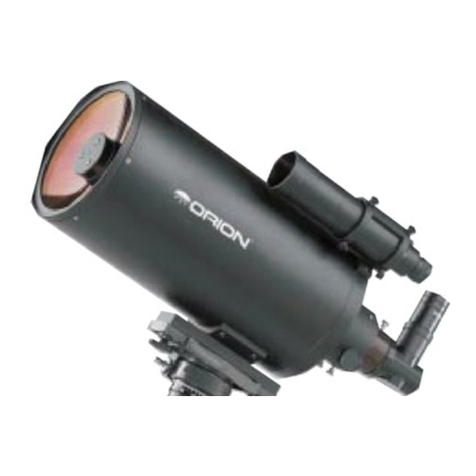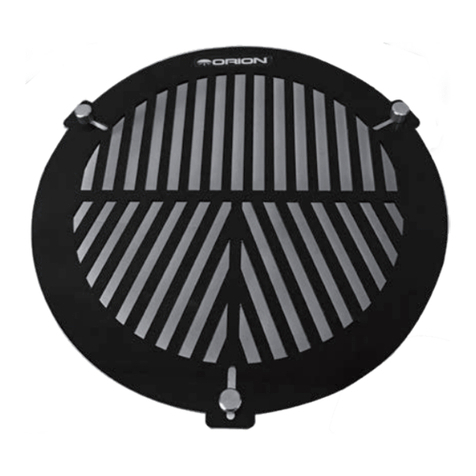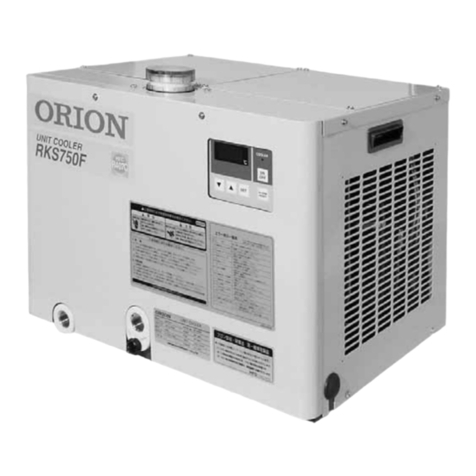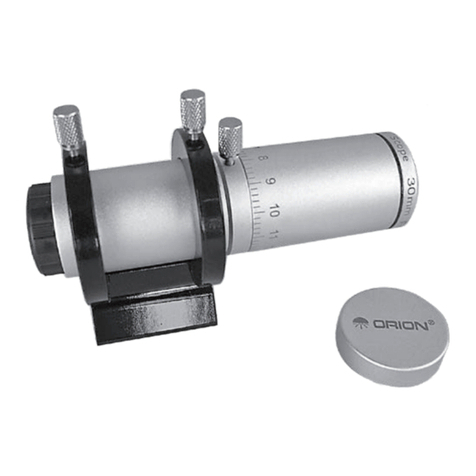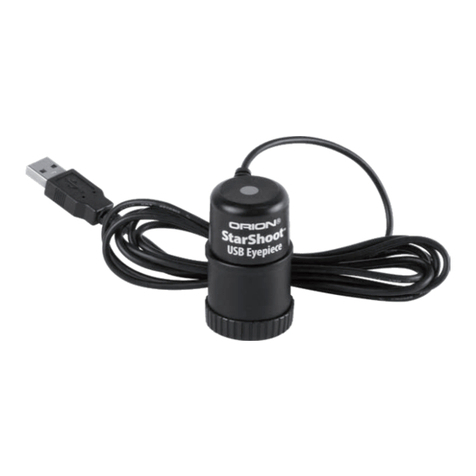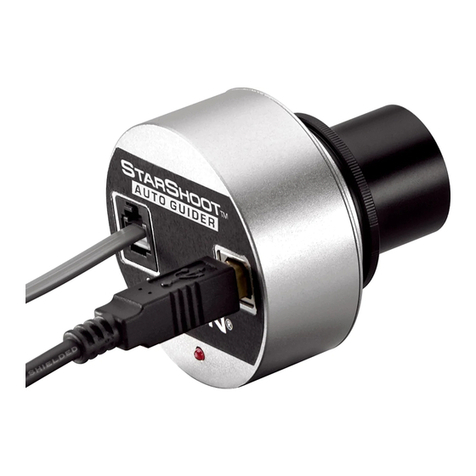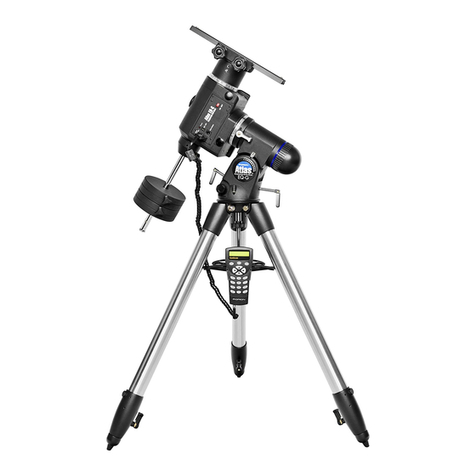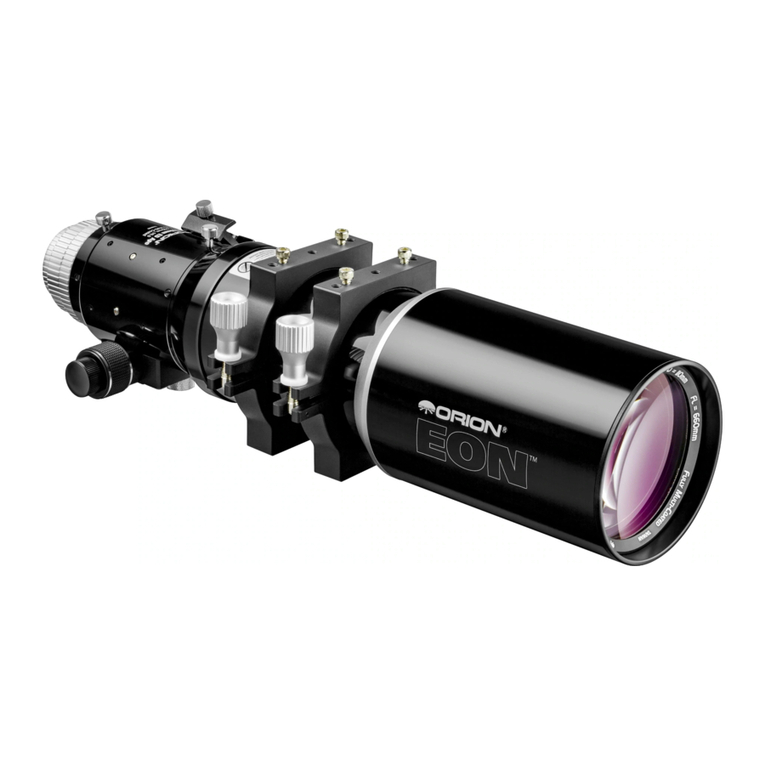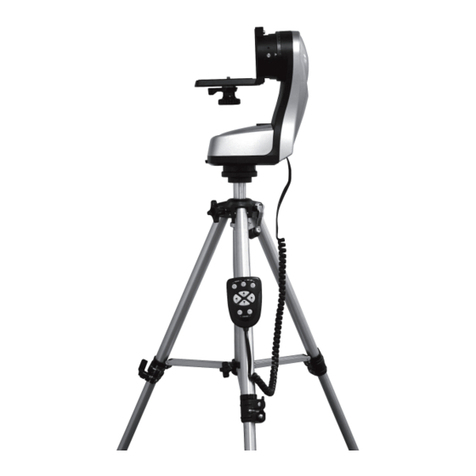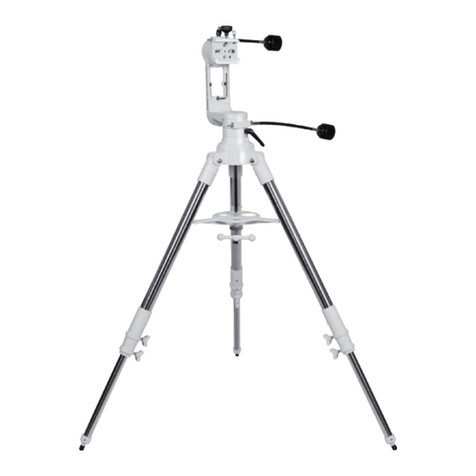
Orion®Collimating Eyepiece
#4411
Congratulations on your purchase of an Orion Collimating Eyepiece! It’s a
practical and easy-to-use tool for insuring that your telescope’s optics are always
in precise alignment, and therefore capable of rendering the best possible resolu-
tion and contrast.
What is Collimation?
Collimation is the process by which an instrument’s optical components are
brought into precise alignment with its optical axis and mechanical axis. In
other words, all the mirrors and/or lenses should be centered and angled so
that light entering the telescope forms a sharp image precisely in the center
of the eyepiece. If the optics are not properly aligned, stars will appear not
as pinpoints as they should, but rather as ared, teardrop-shaped “comets”
or “sea gulls.”
Collimation of Different Telescope Types
Refractor and Maksutov telescopes are collimated at the factory and
generally should not need further adjustment. If collimation does become
necessary later, it is best to have it done at the factory, since these scopes
usually possess no user-adjustable collimation settings.
Collimation is more of an issue with Newtonian reectors and Schmidt-
Cassegrains. Good collimation is particularly critical for “faster” Newtonians,
those with f-ratios of f/6 or lower. Once the collimation is set, it will hold if
care is taken in transporting and handling the optical tube. However, any
sharp jolts can knock the mirrors out of alignment, as can jostling of the
scope in the trunk of a car or temperature changes over a period of time.
Fortunately, these telescopes are equipped with adjustment screws that
permit easy recollimation.
Testing Your Telescope’s Collimation
You can quickly determine whether your telescope is properly collimated.
Just point it at a bright star and slowly rack the image out of focus by with
the focusing knob. If the telescope is correctly collimated, the expanding
disk should be a perfect circle. If it is unsymmetrical, the scope is out of
collimation. In reectors and Schmidt-Cassegrains, the dark shadow cast by
the secondary mirror should appear in the very center of the out-of-focus
circle, like the hole in a doughnut. If the “hole” appears off-center, the tele-
scope is out of collimation.
Purpose of the Collimating Eyepiece
Aligning the mirrors seems easy enough, in theory, but in practice it can be
difficult without the proper tools.
A common way of collimating—the “quick and dirty” method—is to simply
remove the eyepiece and look down the focuser tube to center the mirror
reections. The accuracy of this method, however, is not reliable. For one
thing, there is no way to know whether you are looking straight down the
focuser tube; your line of sight could be off by a degree or two. Another
problem is knowing when the reections of the mirrors are exactly centered.
Just “eyeballing it” isn’t precise enough; the reections may appear to be
centered when in fact they are not.
The Collimating Eyepiece will take care of both of these problems, allowing
you to achieve precise collimation without “guessing,” and thus improve your
telescope’s performance. The Collimating Eyepiece is a combination of a
“sight tube” and a “Cheshire eyepiece.” The sight tube’s narrow eld of view
and crosshairs provide a reference for centering the optical elements during
the collimation process. A Cheshire eyepiece has a polished at set in the
barrel at a 45° angle, which directs light entering from a cutout in the side
of the barrel down into the optical path. The Cheshire allows quick and easy
collimation of the primary mirror, assuming the mirror has been marked
with a spot exactly in its center. (This can be done by rst measuring to
determine the exact center of the mirror, then marking it with a 1/4"-diameter
spot with a black permanent felt-tip marker. (Another alternative is to affix a
white paper hole “reinforcement” at the center, if the black spot is difficult to
see behind the crosshairs of the Collimating Eyepiece.) Because the spot
is positioned where the shadow of the secondary mirror falls, it does not
cause light loss or diffraction. The polished at projects a bright annulus
(doughnut) of light into the optical path, providing a “target” for aligning the
primary mirror.
Anatomy of the Collimating Eyepiece
Using the Collimating Eyepiece
Collimation can be performed in daylight, when it is easier to see what
you’re doing. However, never point the telescope or the cutout side of the
Collimating Eyepiece at, or anywhere near, the Sun, or serious and instant
eye damage could result! Insert the Collimating Eyepiece directly into the
1.25" focuser. When using a 2" focuser, place the Collimating Eyepiece
into a 1.25" adapter. If you use a star diagonal with your telescope, as is
common for Schmidt-Cassegrain telescopes, remove it before inserting the
Collimating Eyepiece. The eyepiece should be inserted to a depth such that
the bottom edge of the eyepiece tube appears slightly wider than the outer
edge of the secondary mirror when you look through the sight hole. Rotate
the eyepiece so that the cutout side is directed toward any available external
light. Make sure there is adequate light in the room or outside so that when
you look through the sight hole, you can see the edges of the secondary
mirror clearly (refer to the diagram). Tighten the thumbscrew on the focuser
tube to secure the Collimating Eyepiece in place. Now, you are ready to
proceed with collimation.
Newtonian Reflectors
1. With the telescope pointed away from the Sun, look into the front of
the telescope tube. Check that the secondary (or diagonal) mirror is
positioned in the center of the tube; use a ruler if necessary to measure
the distance from the center of the secondary mirror holder to the inside
of the tube on different sides. You may have to adjust the spider vanes
or stalk. Also, check to see that the primary mirror is centered in the
optical tube. A quick visual inspection usually suffices. If the primary is
obviously not centered, it will need to be repositioned in its mirror cell.
2. Next, if there is an eyepiece in the telescope, remove it. Look down into
the open focuser tube. You will see the secondary mirror and mirror
holder as well as reections of the secondary mirror and its holder, the
primary mirror, and your eye. It’s pretty confusing, so refer to Figure 1
to sort them all out. (This gure shows what you would see if both the
primary and secondary mirrors were out of alignment and the second-
ary mirror were not centered below the focuser tube.)
IN 070 Rev B 07/17
Rubber fold
down eye
guard
Sight hole
Metal insert
Polished, 45°-angled at
Corporate Offices: 89 Hangar Way, Watsonville CA 95076 - USA
Toll Free USA & Canada: (800) 447-1001
International: +1(831) 763-7000
Copyright © 2022 Orion Telescopes & Binoculars.All Rights Reserved. No part of this product instruction or any of its contents
may be reproduced, copied, modied or adapted, without the prior written consent of Orion Telescopes & Binoculars.
AN EMPLOYEE-OWNED COMPANY
Barrel (ts 1.25" focusers)
Crosshairs (for centering)
